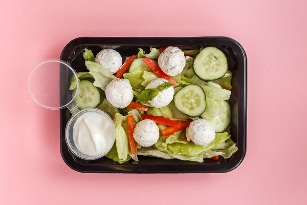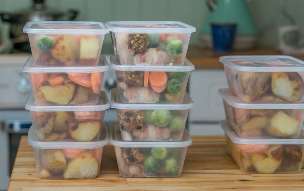What does a healthy eating plan look like? What foods should be excluded from the PP diet, how much protein, carbohydrate and fat should you eat each day?
Basics and rules for healthy eating

For optimal results, especially if you are just starting a healthy lifestyle, you can follow the MyPlate method. That is, you divide each meal into 5 food groups. Read about them below.
Protein
Ideally, protein should make up about 20 percent of your total daily calories.
How much protein should you eat?
You should consume about 0, 8 to 1, 2 grams of protein per kilogram of body weight per day. You should try to divide that amount into all meals and snacks throughout the day, rather than turning them into one or two meals. Protein is especially important if you are trying to achieve weight loss by burning body fat. The fact is that breaking down and assimilating protein requires more energy than any other macronutrient, resulting in more calories being consumed.
Cereals
Cereals often have a bad reputation, as most grain foods today are industrially processed and converted into fast carbohydrates such as sweet grains and white bread. By choosing unprocessed grains and grains, you will immediately get all the benefits of cereals: energy, vitamins and minerals necessary for the normal functioning of the body.
How many cereals do you need?
You need about six servings of cereals or 170 grams a day. A slice of bread and half a cup of cooked rice or pasta counts as a serving. At least half of your servings should be whole grain.
Fruit
What else do you need to include in your weight loss diet? Fruits. Even the fact that the fruit contains sugar, more precisely fructose, is not a problem, as long as you do not exceed the daily amount of calories. Your body needs fructose to stay healthy. Thus, the fruit is naturally sweet, which means that it can satisfy your craving for sugar if you do not want to choke on chocolate at night.
How much fruit do you need?
You should consume about two servings a day. A whole apple, orange or banana is considered one serving.
Which fruit should you choose?
You should eat mainly fresh fruit and limit your intake of fruit juices and processed foods such as apples (unless you have prepared them yourself).
Vegetables
If you really want to know how to eat right to lose weight, just remember vegetables - your new best friend. They are high in fiber, which is good for your digestive system. They are also low in calories and saturation, so you can eat more vegetables than other foods and at the same time consume fewer calories, which ultimately leads to quality weight loss.
How many vegetables should you eat?
You need three to four servings.
What vegetables to choose?
Try to eat lots of dark green leafy vegetables like spinach, cabbage, broccoli and asparagus. Starchy vegetables, such as potatoes, are also beneficial. Cooking vegetables (rather than cooking it because it flushes out all the nutrients) is one way to improve the taste if you don't like to eat them raw.
Dairy products
We consume dairy products because of their high content of vitamins and minerals. These are high-protein foods, so snacks like cottage cheese are perfect if you need to eat something before your next full meal. As dairy products are usually a great source of protein, they are also part of a weight loss kit.
How many dairy products do you need?
About three servings of dairy products are needed about every day. One cup of milk or yogurt counts as one serving.
What if you can't / don't want to consume dairy products?
It is not dairy products that are important for a healthy diet, but their nutrients. So if you can't eat dairy products due to allergies or lactose intolerance, or just don't like them, there are other potential ways to get those essential vitamins and minerals and still get great results.
- Broccoli, cabbage, figs and oranges are high in calcium.
- Dark green leafy vegetables (cabbage, broccoli), tomatoes and citrus fruits contain vitamin C.
- Minerals such as phosphorus, magnesium and iron are found in many other foods you already eat.
- You can also take daily multivitamins to fill any micronutrient deficiencies.
What about fat?
Fats and oils are no longer technically a separate food group. During the diet, you will probably automatically consume the fat needed to stay healthy.
And where can I get fat?
If you eat a healthy variety of foods, you should get all the healthy fats you need. But no more than 30 percent of your daily calories should be from fat.
The Truth About Carbohydrates
You may have heard that not all carbohydrates (sugars) are bad. When you see that experts talk about how bad sugar you have, they usually talk about added sugar. Such sugar is added to our food during processing for a number of reasons and should be limited if it is not excluded.
However, carbohydrates found in grains, fruits, vegetables and dairy products are not moderately harmful. You should not be intimidated by this type of sugar. It turns your body into the energy it needs to stay healthy.
How many calories should I consume per day?

Now that you know how to eat well for weight loss, you're probably still wondering how many calories you can eat per day. Technically, if you don't want to, you don't need to count calories. The standard for men and women is 2000 kcal. You can calculate your calorie needs if you really want to know and track them on a daily basis, but it all depends on what you eat and how active you are. Instead, pay attention to the types of foods and portion sizes, as this can be a much more effective but less difficult way to achieve results.
Calculating Daily Calories for Weight Loss
You can use one of the calorie calculation formulas to find out how many calories you need per day. The most commonly used formula is Tom Venuts. She looks like this:
Men: 66 + (13. 7 x body weight) + (5 x height cm) - (6. 8 x age in years)
Women: 665 + (9, 6 x body weight) + (1, 8 x height cm) - (4, 7 x age in years)
The number obtained is multiplied by the physical activity factor:
- Sedentary work, sedentary lifestyle: 1, 2
- Average stress level (morning exercises 3 times a week) 1, 38
- Heavy Load1, 56
- Very heavy loads1, 73
- Real extreme (you won't be able to wear so much, don't even think. 1. 9
But if you have questions like, “Why can’t you lose weight? ", It may turn out that the daily amount of calories is greatly overestimated and the body simply does not have to waste fat reserves. In this case, it is better to calculate the daily caloric intake and create a menu based on the data obtained. It is especially important to know the caloric content of the diet, once the weight has stopped after achieving certain results, it will be easier to reduce the diet by another 500 calories and continue to lose weight.
One serving is:
- 100-150 grams of vegetables (fist size);
- 150 ml of dairy product;
- 120 g of meat or fish (about the size of a palm; )
- 1 teaspoon oil;
- 12 grapes;
- 1 apple, banana, orange or pear;
- 1/2 mango or grapefruit;
- 1/4 avocado.
Keep track of your balance
In order to lose weight without harming your health and maintaining good health, harmony, your body needs to get enough protein, fat and carbohydrates. Approximate proportions - 75 g protein: 60 g fat: 250 g carbohydrates: 30 g fiber. Foods that contain protein are sources of amino acids to build muscle fibers, maintain healthy skin, hair, nails, fat for the proper functioning of the brain and nervous system, as well as the skin, and carbohydrates are a source of energy.
Is meal time important?
Optional. Make it easy for yourself and eat when you're hungry, even if it's just a snack. If you want to eat six small meals a day instead of three large meals a day, do so. If you like to excite yourself every few hours, then it is enough to eat 3 times a day at a convenient time. Just don't skip meals (you end up eating, but somewhere at night and sabotaging potentially quality results). Diet is important, but not in terms of time, but in terms of quality.
Menu and meal planning
Every day, you can eat a number of wholesome and balanced meals while maintaining a healthy diet. The secret is to eat a variety of dishes. Below is a sample breakfast, lunch and dinner menu to help you start planning your meals.
Daily dose:
Breakfast
- Lean Greek yogurt or oatmeal with fruit and granola
- Half-bread with nonfat cream cheese
Lunch
- 2 charm products (tortilla, beef, salad, guacomole, sour cream)
- 1 bowl of boiled brown rice with fried beans
Dinner
- Small salad (lettuce, red onion, tomato, cheese, Italian sauce)
- Fried chicken breast
- 1 bowl of green beans
- Fried potatoes with cheese
Snack ideas
- Celery and nut butter
- Fresh vegetables with hummus
- Sliced fruit and whipped cream
- Apple sauce
- Pretzel
- Dried fruits
- Nuts
- Tortillas and salsa
- Pickled cucumbers
Shopping List
Here are some examples of healthy foods you can buy at your local grocery store. Knowing which foods to buy is part of a weight loss kit.
Healthy food:
- Meat (steak, pork, beef)
- Fish and Shellfish
- Eggs
- Nuts and seeds
- Cereals
- Whole grain pasta
- Brown rice
- Buckwheat
- Wholemeal bread
- Greek yogurt
- Cheese
- Milk or soy milk
- Avocado
- Oily fish like salmon
- Nuts
- Fatty Yogurt
Healthy Eating Planning Guide for Beginners

Meal planning is one of the easiest and healthiest things you can do to achieve weight loss results through a healthy diet. Whether it's just a day or an entire week, it's up to you. A properly formulated diet not only gives us the opportunity to lose weight, but it is also simply convenient if all food issues are resolved in advance. When delicious and healthy food ingredients are waiting for us at home, it becomes easier to avoid the purchase of something harmful.
1. How much food do you need?
Let's think about our and our loved ones' weekly plans first. From here we can get a rough idea of how much food we need. This can be, for example: six breakfasts all, five family dinners, one lunch four times and one afternoon snack.
2. How long will it take to cook?
This is a very important element of effective meal planning and is often overlooked or forgotten. You can create as many plans as you want, but if you don't have enough time to complete them, then what is their use? With that in mind, expand your list with pre-prepared dinners and lunches. This means that you must first get acquainted with the dishes you will prepare - the more information you find about them, the easier it will be to find dishes that fit easily into your schedule.
If you're looking forward to a hard week's work, consider fast meals, reheated meals, or quick-cooked pre-cooked meals. After all, we don’t want to spend time cooking five times a day. Once you work as a chef, you can cook several dishes at once, which will be eaten all week. For example, make chili or fry two chickens at once to make it enough for both today 's and next dinner. In addition, it will be a tasty and healthy addition to sandwiches and salads.
3. Food Choices and Schedule
Using your list, choose meals that fit organically into your schedule. Also check out your favorite food or browse the recipe book. You also need to consider the time of year, what is now sold from seasonal vegetables and what everyone would like to eat. When planning, you should also remember the expiration date of the products. For example, fish dishes must be prepared within one to two days of purchase, while frozen or dry dishes can be prepared later.
You also need to be able to use all the ingredients wisely so that nothing is thrown away. This way you can save both time and money. If you want to eat better and spend less money, then buy seasonal products and look for products with discounts and promotions.
Create a list of the best recipes. A list of dishes suitable for you and your family is one of the easiest ways to calculate and improve the meal planning process. Every time you find a recipe for a meal you like, add it to this list. You can also keep your recipes in the fitness diary. This will not only help you with your diet, but also make it easier to plan meals.
4. Enter everything on the calendar
It doesn't matter which calendar you're using, whether it's on your computer screen or on the wall. But it is always better to keep a paper copy of the calendar in a visible place. It is usually hung on the refrigerator. When today's food plan is visible, we become more responsible for preparing it. Also, your family won’t constantly ask, “What’s for dinner today? ” They can just look at the calendar.
If you want a digital calendar, you can create today's meal plan on your phone and share this menu with friends and family.
5. Create shopping lists
It's best to do this while filling out your calendar. Remember to write down the quantity of each product you need and check how much you have left so that you do not accidentally buy too much. You can save time by grouping the products in the list when they appear in the store. For many supermarkets, this is:
- Fruits and vegetables
- Bread and grains
- Spices and baking products
- Oils
- Crackers
- Drinks
- Dairy products
- Meat and eggs
6. Cooking and cooking
Chop vegetables, grate cheese, make sauces - just prepare what we can in advance. You can even measure spices, boil potatoes or fry vegetables.
Meal planning not only puts us at the forefront of achieving a healthy diet, but also saves a lot of time because we can prepare the ingredients while you have free time.














































































